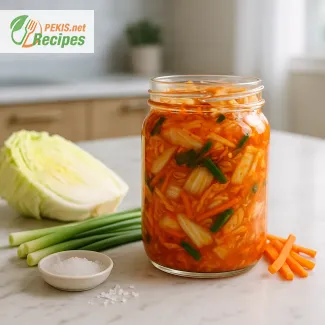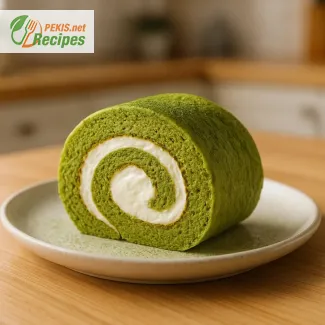A mildly spiced homemade kimchi with extended fermentation develops a deep, rounded flavour and a silky–crisp texture that grows richer over time. Born from traditional Korean preserving methods, this version highlights napa cabbage, garlic, ginger and gochugaru, creating a balanced ferment that feels vibrant, comforting and full of character.
Drawing on years of working with long-fermented foods, one small insight always makes a difference: letting cabbage rest a little longer after salting creates a more supple texture that absorbs flavours beautifully. These small adjustments shape a deeper, more expressive ferment. PEKIS – professional chef and recipe developer with over 25 years of experience in cooking and baking, specialised in European and international cuisine.

Fermentation techniques that enrich mildly spiced homemade kimchi
How extended ageing shapes deeper flavour, aroma and texture
The first crackle of crisp fermented cabbage releasing its gentle warmth feels almost cinematic—the kind of moment when aroma and texture collide before the first bite even reaches the palate. A mildly spiced kimchi with a longer ageing period builds its depth slowly, allowing the cabbage to turn silky yet still firm, holding a delicate balance between tanginess and natural sweetness. As the days pass, the ferment gains roundness and subtle complexity, creating a profile that feels softer, smoother and profoundly satisfying without overwhelming heat.
Mild kimchi has roots stretching deep into Korean culinary history, where fermentation was once a vital method of preserving vegetables for long, cold winters. Over centuries, countless regional varieties emerged, each reflecting local soil, climate and family traditions. The slow-aged version sits among the gentler interpretations of this heritage—still boldly aromatic, still grounded in umami, but crafted for those who appreciate layered flavour over intensity.
Garlic, ginger and Korean chili flakes shape the aromatic foundation, bringing warm spice and earthy fragrance. Salt helps the cabbage release moisture, creating the brine that encourages beneficial microorganisms to flourish. As fermentation progresses, naturally occurring sugars convert into acids that deepen the flavour, creating that signature balance of subtle heat and vibrant tang. The extended ageing period allows these transformations to settle, giving the final kimchi a more rounded, mellow character ideal for rice dishes, stews, noodles or grain bowls.
Storage and make-ahead guidance
This ferment thrives when given time. Once prepared, it continues developing flavour for weeks, even months, in cold storage. Keeping it refrigerated slows the process while preserving texture and aroma. A freshly made batch can be divided into smaller jars to enjoy at different stages of maturity—from bright and youthful to deeply savoury.
Ingredient behaviour and sensory impact
Each element influences the long fermentation process in distinct ways:
- Salt regulates moisture release and supports beneficial bacteria
- Garlic adds warm intensity and earthy depth
- Ginger lifts the flavour with subtle heat
- Chili flakes create gentle spice without overpowering
- Cabbage structure provides the signature crunch-to-softness contrast
Why you’ll love this recipe
- Naturally mild heat with deep, well-rounded flavour
- Enhanced umami from extended fermentation
- Versatile pairing with rice, stews, noodles, bowls and grilled dishes
- Long storage life, improving gradually over time
- Ideal for those who prefer balanced spice rather than intensity
Creative variations
- Include daikon slices for extra crunch and sweetness
- Add Korean pear for a hint of natural fruitiness
- Use mustard greens or pak choi for lighter, peppery notes
- Introduce a touch of gochugaru-oil for a silkier texture
- Ferment in smaller jars to compare different ageing stages
Fermentation contexts and related culinary traditions
Fermented dishes often appear in broader meal-prep frameworks. For those exploring balanced, nutrient-dense bowls, a related option is available in English:
High-Protein Fermented Veggie Bowl with Summer Greens for Easy Meal Prep
Traditional fermentation also connects to ancient techniques such as the Peruvian potato preparation Tocosh. A comparable English recipe is here:
Fermented Potato Pulp Tocosh – Ancient Peruvian Remedy for Gut Health
- Cut the napa cabbage lengthwise into quarters, remove the core, and slice into large bite-size pieces.
- Dissolve coarse sea salt in water and pour the brine over the cabbage. Massage gently to help draw out moisture.
- Allow the cabbage to brine for 2 hours, stirring occasionally to ensure even softening.
- Rinse thoroughly to remove excess salt, then drain very well.
- In a bowl, mix garlic, ginger, gochugaru, fish sauce, sugar, spring onions and carrot to form a thick seasoning paste.
- Wearing gloves, coat the cabbage evenly with the paste, ensuring all leaves are covered.
- Pack the mixture tightly into sterilised glass jars, pressing down to expel air pockets.
- Leave space at the top of each jar to allow gas release during fermentation.
- Ferment at room temperature (20–22 °C / 68–72 °F) for 1–2 days depending on preferred sourness.
- Refrigerate to slow the fermentation and deepen the flavour.
FAQ questionHow long should homemade mild kimchi ferment for the best flavour?
For a mild kimchi with extended fermentation, aim for a two-stage process. First, let it ferment at room temperature for 1–2 days until small bubbles appear and the aroma turns tangy. Then move it to the refrigerator, where it can slowly mature over 1–3 weeks or even longer. The longer it stays chilled, the more rounded, complex and deep the flavour becomes, while the heat from the chili stays gentle. Tasting a small amount every few days helps find the perfect point between fresh brightness and fully developed sourness.
FAQ questionHow can the spice level be kept mild while still tasting like real kimchi?
To keep the heat controlled, reduce the amount of chili flakes and focus on aroma-building ingredients like garlic, ginger and fish sauce. Using less gochugaru but keeping the same base of cabbage, aromatics and salt preserves the characteristic kimchi profile without aggressive burn. Extended fermentation also helps: over time, flavours blend and soften, turning sharp heat into a more balanced, mellow warmth that still feels authentically Korean-inspired.
FAQ questionWhy is napa cabbage preferred for this type of kimchi?
Napa cabbage has a naturally tender yet sturdy structure, with thick white ribs and delicate leaves that respond beautifully to brining and slow fermentation. The ribs stay pleasantly crunchy, while the leaves soften and soak up the seasoning paste. This contrast in texture makes each bite feel layered and satisfying. Napa cabbage also has a gentle sweetness that, after extended fermentation, turns into a deep, savoury tang, ideal for a mildly spiced kimchi that focuses on complexity rather than intensity.
FAQ questionHow can texture be kept crunchy during long fermentation?
Crunch depends on proper salting, draining and packing. Salting should draw out moisture without fully wilting the cabbage; over-salting or brining too long can make it limp. After rinsing, draining thoroughly ensures the brine concentration stays right and prevents waterlogging. Packing the cabbage tightly into jars, while leaving some headspace, keeps oxygen low and supports stable fermentation. Storing the kimchi in the refrigerator after the initial room-temperature phase slows down softening, preserving a firm, crisp bite even with extended ageing.
FAQ questionWhat is the best way to use mild, slow-fermented kimchi in meals?
Mild kimchi with long fermentation works especially well as a versatile side and flavour booster. It can be served cold with steamed rice, added to grain bowls, folded into omelettes, tucked into sandwiches or used as a topping for noodles and soups. Because the heat level is gentle, it pairs nicely with grilled meats, tofu, roasted vegetables and eggs without overpowering them. The deep acidity and umami lift otherwise simple dishes, turning everyday meals into something more layered and interesting.
FAQ questionHow can the fermentation process be safely controlled at home?
Safe fermentation depends on clean equipment, correct salting and proper temperature control. Using sterilised jars and clean utensils reduces unwanted microbes. The salt level must be high enough to discourage spoilage organisms while allowing beneficial bacteria to thrive. During the first days, jars should be kept at a stable, cool room temperature and checked daily to release trapped gas if needed. Once the desired level of tang is reached, transferring the kimchi to the refrigerator keeps it in a slow, controlled ferment, extending shelf life and maintaining quality.
A mildly spiced kimchi gains remarkable depth when given time to mature, allowing each ingredient to build layers of umami, gentle heat and natural sweetness. The extended ageing process turns simple cabbage into something expressive, with flavours that continue to evolve long after it reaches the jar.
As the ferment rests, its balance becomes more refined. The garlic and ginger soften into a warm aromatic core, while the gochugaru settles into a smooth, mellow warmth instead of sharp heat. This slower transformation creates a kimchi that suits a wide range of dishes without overpowering them.
The combination of crisp cabbage ribs and tender leaves adds contrast to every bite. A ferment like this works beautifully both on its own and as part of larger meals, offering a naturally vibrant, tangy brightness that lifts grains, noodles, soups and proteins.
Slow-fermented kimchi also keeps well, becoming richer week by week. With simple ingredients and controlled fermentation, it delivers a consistently satisfying result that feels grounded in tradition yet easy to integrate into everyday cooking.
Allergens present in the recipe:
- Fish: present due to fish sauce
Suggestions to remove allergens:
- Replace fish sauce with soy sauce for a fish-free version
- Replace soy entirely with coconut aminos for a soy-free alternative
- Use a salt brine only for a fully allergen-light version
- Vitamin C (mg): 18 – supports immune system
- Vitamin K (mcg): 55 – essential for bone health
- Potassium (mg): 220 – helps maintain fluid balance
- Calcium (mg): 45 – contributes to bone strength
- Iron (mg): 0.8 – supports oxygen transport
- Beta-carotene (mg): 0.4 – supports vision and skin
- Flavonoids (mg): 18 – assist in cellular protection
- Phenolic acids (mg): 12 – provide anti-inflammatory support





